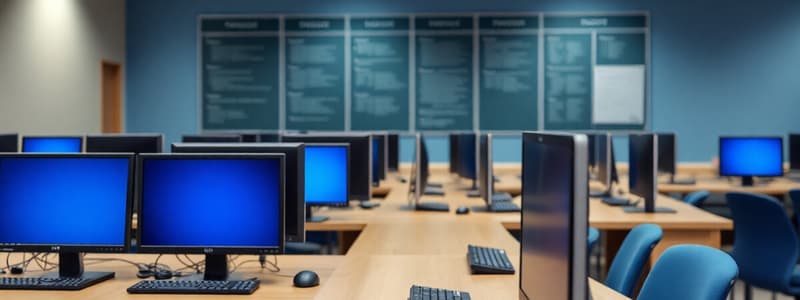Podcast
Questions and Answers
Which computing device was invented first?
Which computing device was invented first?
- Jacquard Loom
- Analytical Engine
- Pascal's Calculator
- Abacus (correct)
What is the primary function of Pascal's Calculator?
What is the primary function of Pascal's Calculator?
- Addition and subtraction (correct)
- To execute programmable tasks
- To manage data processing
- To perform polynomial computations
Who is credited with the first computer program?
Who is credited with the first computer program?
- Ada Lovelace (correct)
- Charles Babbage
- Herman Hollerith
- Blaise Pascal
What significant advancement did the Jacquard Loom introduce in computing history?
What significant advancement did the Jacquard Loom introduce in computing history?
What was the purpose of the Difference Engine created by Charles Babbage?
What was the purpose of the Difference Engine created by Charles Babbage?
In what year did Herman Hollerith develop the punched card tabulating machines?
In what year did Herman Hollerith develop the punched card tabulating machines?
Who introduced the concept of the Turing Machine?
Who introduced the concept of the Turing Machine?
What was the purpose of the Colossus computer developed during World War II?
What was the purpose of the Colossus computer developed during World War II?
Which component is not typically considered part of a computer's fundamental architecture?
Which component is not typically considered part of a computer's fundamental architecture?
What significant technology was introduced in 1947 that revolutionized computing?
What significant technology was introduced in 1947 that revolutionized computing?
What percentage of the grading system is dedicated to attendance?
What percentage of the grading system is dedicated to attendance?
Which computer is considered the first commercially available computer?
Which computer is considered the first commercially available computer?
Which programming language was developed as the first high-level programming language?
Which programming language was developed as the first high-level programming language?
Which technological invention led to the miniaturization of computers in 1958?
Which technological invention led to the miniaturization of computers in 1958?
In what year was the first microprocessor, the Intel 4004, introduced?
In what year was the first microprocessor, the Intel 4004, introduced?
What was the groundbreaking release from IBM in 1964 that established compatibility standards?
What was the groundbreaking release from IBM in 1964 that established compatibility standards?
What was the original name of the first web browser created in 1990?
What was the original name of the first web browser created in 1990?
Who set up the first web server and website in 1991?
Who set up the first web server and website in 1991?
What year was the World Wide Web technology released to the public domain?
What year was the World Wide Web technology released to the public domain?
What was significant about the Mosaic web browser released in 1993?
What was significant about the Mosaic web browser released in 1993?
What organization was founded by Tim Berners-Lee in 1994 to ensure web standards?
What organization was founded by Tim Berners-Lee in 1994 to ensure web standards?
Which era is characterized by the rise of user-generated content and social networking?
Which era is characterized by the rise of user-generated content and social networking?
What factor contributed to the mobile revolution in web usage?
What factor contributed to the mobile revolution in web usage?
What is the primary function of the CPU in a computer?
What is the primary function of the CPU in a computer?
Which technologies are currently shaping the future of the World Wide Web?
Which technologies are currently shaping the future of the World Wide Web?
Which component provides the necessary electrical power to other parts of the computer?
Which component provides the necessary electrical power to other parts of the computer?
What is the main purpose of RAM in a computer?
What is the main purpose of RAM in a computer?
What distinguishes SSDs from HDDs in terms of data storage technology?
What distinguishes SSDs from HDDs in terms of data storage technology?
What role does the motherboard play in a computer?
What role does the motherboard play in a computer?
Which of the following statements about the GPU is true?
Which of the following statements about the GPU is true?
What is the primary purpose of a cooling system in a computer?
What is the primary purpose of a cooling system in a computer?
Which component primarily protects and houses all other computer parts?
Which component primarily protects and houses all other computer parts?
What is the primary function of a Network Interface Card (NIC)?
What is the primary function of a Network Interface Card (NIC)?
Which type of software is responsible for managing hardware components?
Which type of software is responsible for managing hardware components?
What type of peripherals are used to connect external devices to a computer?
What type of peripherals are used to connect external devices to a computer?
Which component is becoming less common due to digital distribution?
Which component is becoming less common due to digital distribution?
Which software type includes tools to optimize computer systems?
Which software type includes tools to optimize computer systems?
What is the role of device drivers in a computer system?
What is the role of device drivers in a computer system?
What type of software allows users to perform specific tasks or functions?
What type of software allows users to perform specific tasks or functions?
Which component is essential for interacting with a computer but is not part of the core components?
Which component is essential for interacting with a computer but is not part of the core components?
Flashcards are hidden until you start studying
Study Notes
Class Schedule and Exams
- Prelim exams are scheduled for September 18-20.
- Midterm exams will occur from October 16-21.
- Semi-finals are set for November 20 and 22.
- Final exams take place from December 11-16.
Grading System
- Quizzes and assignments account for 40% of the final grade.
- Activities and term exams also constitute 40% of the assessment.
- Attendance contributes to the remaining 20%.
Milestones in Computing History
- 3000 BC: The abacus, an early computing device, is invented for arithmetic calculations.
- 1642 AD: Blaise Pascal invents the Pascaline, a mechanical calculator for addition and subtraction.
- 1801: The Jacquard Loom uses punched cards, representing early programmable machinery.
- 1822: Charles Babbage designs the Difference Engine, an early mechanical computer for polynomial functions.
- 1837: Ada Lovelace writes the first algorithm for Babbage’s Analytical Engine.
- Late 1800s: Herman Hollerith develops punched card tabulating machines for the 1890 U.S. Census.
- 1936: Alan Turing introduces the Turing Machine, a theoretical model for algorithmic processes.
- 1937: First electronic digital computer designed by Claude Shannon at MIT using switches and relays.
- 1941: Konrad Zuse builds Z3, the first programmable digital computer with electromechanical relays.
- 1943-1945: Development of Colossus and ENIAC during WWII, foundational computers for code-breaking and general purposes.
- 1947: Transistors are invented, enhancing reliability and efficiency in computers.
- 1951: UNIVAC I becomes the first commercially available computer.
- 1953: IBM introduces IBM 701, its first successful general-purpose computer.
- 1954: FORTRAN emerges as the first high-level programming language.
- 1958: Integrated circuits are independently invented, leading to smaller computers.
- 1964: IBM System/360 sets new standards for compatibility in mainframes.
- 1969: Creation of ARPANET, the precursor to the internet.
- 1971: Intel releases the first microprocessor, leading to personal computers.
- 1973: Ethernet technology is developed, forming the backbone of local area networks.
Evolution of the World Wide Web
- 1991: The first web server and website created by Tim Berners-Lee.
- 1993: CERN publicly releases web technology, initiating rapid growth.
- 1993: Mosaic web browser is launched, increasing public accessibility to the Web.
- Late 1990s: Commercialization and dot-com boom spur development of online businesses.
- 1994: Foundation of World Wide Web Consortium (W3C) to standardize web technologies.
- 2000s: Web 2.0 emphasizes user-generated content and social networking; platforms like Facebook and YouTube rise.
- Mobile Revolution: Increased smartphone usage leads to mobile-optimized websites and applications.
- Today: Ongoing advancements in AI, virtual reality, and IoT continue to shape the Web.
Computer Components
- Central Processing Unit (CPU): Acts as the computer's brain for calculations and executing instructions.
- Motherboard: Main circuit board connecting all components and facilitating data transfer.
- Random Access Memory (RAM): Temporary memory for fast access while the computer operates.
- Storage Devices: HDDs use spinning disks, while SSDs use flash memory for permanent data storage.
- Power Supply Unit (PSU): Converts wall electricity to power the computer’s components.
- Graphics Processing Unit (GPU): Renders graphics and is crucial for gaming and visual tasks.
- Cooling System: Prevents overheating using fans and heat sinks.
- Computer Case: Protects and organizes internal components; allows for connection of peripherals.
- Optical Drive: Reads/writes optical discs, though usage is declining in favor of digital downloads.
- Network Interface Card (NIC): Connects to networks for internet access.
- Sound Card: Enhances audio quality for applications like gaming.
- Input and Output Ports: Facilitate connections with external devices (USB, HDMI, etc.).
- Peripherals: External devices like keyboards and monitors, essential for user interaction.
Computer Software
- System Software: Manages hardware components, includes operating systems, device drivers, and utilities.
- Operating Systems (OS): Core software for user interface and hardware resource management.
- Device Drivers: Facilitate communication between OS and hardware.
- Utilities: Tools for system management and optimization.
- Application Software: Designed to perform specific tasks or functions for user interaction.
Studying That Suits You
Use AI to generate personalized quizzes and flashcards to suit your learning preferences.




